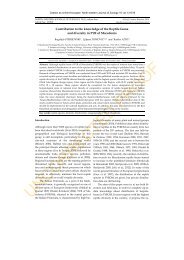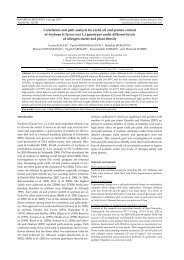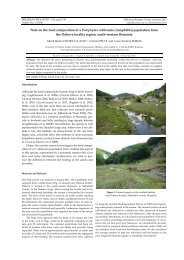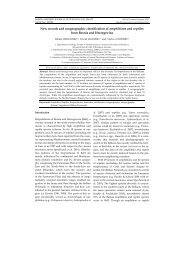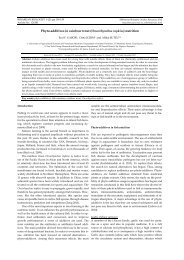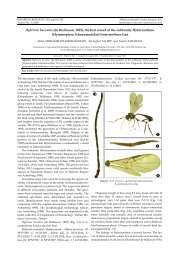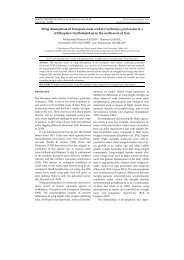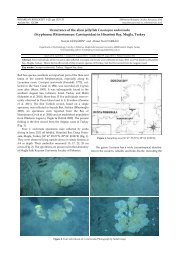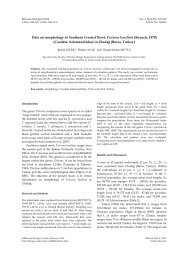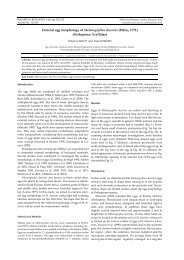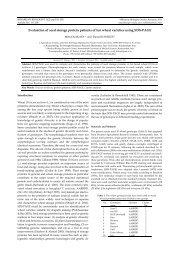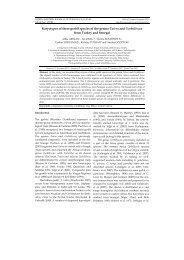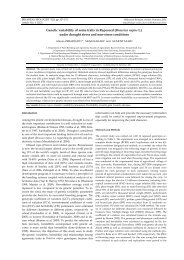Antimicrobial activity of Rosemary, Fennel and Galbanum essential ...
Antimicrobial activity of Rosemary, Fennel and Galbanum essential ...
Antimicrobial activity of Rosemary, Fennel and Galbanum essential ...
You also want an ePaper? Increase the reach of your titles
YUMPU automatically turns print PDFs into web optimized ePapers that Google loves.
<strong>Antimicrobial</strong> <strong>activity</strong> <strong>of</strong> <strong>Rosemary</strong>, <strong>Fennel</strong> <strong>and</strong> <strong>Galbanum</strong> <strong>essential</strong> oils against clinical isolates <strong>of</strong> Staphylococcus aureus<br />
maining at 4 °C for 2 h, plates were incubated for 24 h at 37 °C. The<br />
diameters <strong>of</strong> the inhibition zones were measured in millimeters. All tests<br />
were performed in triplicate (NCCLS 2009).<br />
Determination <strong>of</strong> minimum inhibitory <strong>and</strong> bactericidal concentrations<br />
The minimum inhibitory concentration (MIC) <strong>and</strong> minimum bactericidal<br />
concentration (MBC) values <strong>of</strong> oil were determined by micro broth dilution<br />
assay. The oil was tw<strong>of</strong>old serially diluted with 10% DMSO containing<br />
32-0.0125 µl/ml <strong>of</strong> oil. These dilutions were prepared in a 96-well micro<br />
titter plate. Cation adjusted Muller Hinton broth was used as broth<br />
media. After shaking, 100 µl <strong>of</strong> oil was added to each well. The above microbial<br />
suspensions were diluted (1-5 x10 6 CFU/ml) <strong>and</strong> then 100 µl was<br />
added to each well <strong>and</strong> incubated at 35 °C. MIC was defined as the lowest<br />
concentration <strong>of</strong> oil that inhibits bacteria after 24. MBC value was the first<br />
well that showed no growth on Manitol Salt Agar (NCCLS 2009).<br />
Results<br />
Analyses <strong>of</strong> galbanum oil revealed forty four components<br />
which accounted for 100% <strong>of</strong> the total composition <strong>of</strong> oil, βpinene<br />
(43.1%) <strong>and</strong> α-pinene (5.4%) were the main component<br />
<strong>of</strong> <strong>essential</strong> oil followed by β-cubebene (4.9%), epibicyclosesquiphell<strong>and</strong>rene<br />
(4.4%), p-cymene <strong>and</strong> 4-terpineol<br />
(4.1%) (Table 1).<br />
Table1. Chemical composition <strong>of</strong> F. gummosa <strong>essential</strong> oil<br />
( aRI: Retention Index).<br />
α- thujene<br />
α- pinene<br />
β- pinene<br />
β- myrcene<br />
3-carene<br />
p-cymene<br />
β- phell<strong>and</strong>rene<br />
1-limonene<br />
Compounds<br />
Trans sabinene hydrate<br />
Cis sabinene hydrate<br />
4-terpineol<br />
cyclosativene<br />
α- copaene<br />
β-elemene<br />
alloaromadendrene<br />
Delta selinene<br />
Epi-bicyclosesquiphell<strong>and</strong>rene<br />
soledene<br />
Gamma-cadinene<br />
α-amorphene<br />
Cis calamenene<br />
Delta cadinene<br />
eremophilene<br />
β- bisabolene<br />
spathulenol<br />
guaiol<br />
Cadina-1,4-diene<br />
Beta cubebene<br />
bulnesol<br />
14-norcadin-5-en-4-one isomer A<br />
viridiflorol<br />
RI a<br />
852<br />
860<br />
905<br />
915<br />
931<br />
942<br />
946<br />
949<br />
980<br />
1007<br />
1080<br />
1276<br />
1288<br />
1303<br />
1334<br />
1341<br />
1351<br />
1374<br />
1384<br />
1385<br />
1387<br />
1390<br />
1393<br />
1404<br />
1442<br />
1459<br />
1476<br />
1506<br />
1528<br />
1532<br />
1534<br />
(%)<br />
2.5<br />
5.4<br />
43.1<br />
Thirty three components were identified from rosemary<br />
<strong>essential</strong> oil representing 89.8% <strong>of</strong> the total oil. The major<br />
components were α-pinene (21.5%) <strong>and</strong> 1,8-cineole (15.2%)<br />
0.6<br />
0.6<br />
4.1<br />
0.3<br />
0.8<br />
1.2<br />
1.2<br />
4.1<br />
0.6<br />
0.7<br />
0.6<br />
0.8<br />
1.7<br />
4.4<br />
0.6<br />
4.1<br />
1.8<br />
1.0<br />
2.0<br />
0.7<br />
0.8<br />
2.7<br />
0.9<br />
0.8<br />
4.9<br />
1.2<br />
1.4<br />
0.6<br />
followed by verbenone (8.6%), camphor (6.8%) <strong>and</strong> camphene<br />
(6.3%) (Table 2).<br />
Among twenty six identified components <strong>of</strong> fennel oil,<br />
representing 99.9% <strong>of</strong> total composition, trans-anethole<br />
(56.6%), β-thujone (13.2%) were found as the major compounds.<br />
p-anisaldehyde (8.7%), fenchone (7.42%) were other<br />
main components <strong>of</strong> fennel oil (Table 3).<br />
The antistaphylococcal <strong>activity</strong> <strong>of</strong> <strong>essential</strong> oils by disc<br />
diffusion method exhibited that this effect increased in a<br />
dose dependent manner. Inhibition zone diameters <strong>of</strong> galbanum,<br />
fennel <strong>and</strong> rosemary oils were in compatible with vancomycin<br />
(30 μg) at 10, 15, >20 μl <strong>of</strong> oils, respectively.<br />
Table2. Chemical composition <strong>of</strong> R. <strong>of</strong>ficinalis L. <strong>essential</strong> oil.<br />
Compounds<br />
tricyclene<br />
α- pinene<br />
camphene<br />
β- pinene<br />
3-octanone<br />
β- myrcene<br />
p-cymene<br />
1,8-cineole<br />
1-limonene<br />
Linalool<br />
chrysanthenone<br />
Camphor<br />
borneol<br />
4-terpineol<br />
verbenone<br />
(+)-2,2,3-trimethylcyclopent-<br />
3-ene-1-ethanol<br />
geraniol<br />
Borneol acetate<br />
Trans caryophyllene<br />
Caryphyllene oxide<br />
RI<br />
844<br />
863<br />
873<br />
898<br />
900<br />
914<br />
944<br />
950<br />
951<br />
1015<br />
1018<br />
1038<br />
1069<br />
1077<br />
1097<br />
1102<br />
1151<br />
1174<br />
1321<br />
1433<br />
(%)<br />
0.5<br />
21.5<br />
6.3<br />
3.5<br />
0.8<br />
1.6<br />
3.0<br />
15.2<br />
Table3. Chemical composition <strong>of</strong> F. vulgare L. <strong>essential</strong> oil.<br />
Compounds<br />
α- pinene<br />
sabinene<br />
β-pinene<br />
β- myrcene<br />
p-cymene<br />
1,8-cineole<br />
1-limonene<br />
fenchone<br />
camphor<br />
p-allylanisole<br />
carvone<br />
m-anisaldehyde<br />
p-anisaldehyde<br />
Trans anethole<br />
β-thujaplicin<br />
1-m-anisyl-1-propanone<br />
1-(4-methoxyphenyl)-2-methyl-6methoxy<br />
benzimidazole<br />
1-propanone,1-(4-methoxy phenyl)<br />
RI<br />
855<br />
892<br />
894<br />
912<br />
936<br />
942<br />
948<br />
992<br />
1032<br />
1089<br />
1122<br />
1126<br />
1141<br />
1185<br />
1269<br />
1320<br />
2103<br />
2161<br />
2.8<br />
2.6<br />
1.0<br />
6.8<br />
8.6<br />
1.5<br />
8.6<br />
1.0<br />
1.8<br />
6.1<br />
1.7<br />
1.7<br />
(%)<br />
0.4<br />
0.2<br />
0.1<br />
0.1<br />
0.2<br />
0.3<br />
4.2<br />
7.42<br />
0.3<br />
3.4<br />
1.4<br />
1.4<br />
8.7<br />
56.6<br />
13.2<br />
The diameter <strong>of</strong> growth inhibition zones ranged from<br />
11.6-34.2 mm at 10-20 μl <strong>of</strong> galbanum oil with the highest in-<br />
0.2<br />
0.2<br />
0.7<br />
5



